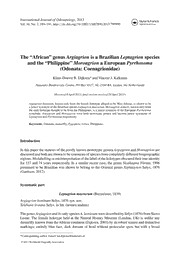
The “African” genusArgiagrionis a BrazilianLeptagrionspecies and the “Philippine”Moroagriona EuropeanPyrrhosoma(Odonata: Coenagrionidae) PDF
Preview The “African” genusArgiagrionis a BrazilianLeptagrionspecies and the “Philippine”Moroagriona EuropeanPyrrhosoma(Odonata: Coenagrionidae)
InternationalJournalofOdonatology,2013 Vol.16,No.2,189–191,http://dx.doi.org/10.1080/13887890.2013.799990 The “African” genusArgiagrion is a Brazilian Leptagrion species and the “Philippine” Moroagrion a European Pyrrhosoma (Odonata: Coenagrionidae) Klaas-DouweB.Dijkstra*andVincentJ.Kalkman NaturalisBiodiversityCentre,POBox9517,NL-2300RA,Leiden,theNetherlands (Received8April2013;finalversionreceived24April2013) Argiagrionleoninum,knownonlyfromthefemaleholotypeallegedtobeWestAfrican,isshowntobe ajuniorsynonymoftheBrazilianspeciesLeptagrionmacrurum.Moroagriondanielli,knownonlyfrom themaleholotypethoughttobefromthePhilippines,isajuniorsynonymoftheEuropeanPyrrhosoma nymphula.Argiagrion and Moroagrion were both monotypic genera and become junior synonyms of LeptagrionandPyrrhosomarespectively. Keywords: Odonata;damselfly;Zygoptera;Africa,Philippines Introduction InthispaperthestatusesofthepoorlyknownmonotypicgeneraArgiagrionandMoroagrionare discussedandbothareshowntobesynonymsofspeciesfromcompletelydifferentbiogeographic regions.Mislabellingormisinterpretationofthelabeloftheholotypesobscuredtheirtrueidentity for 137 and 74 years respectively. In a similar recent case, the genus Skiallagma Förster, 1906 presumed to be Brazilian was shown to belong to the Oriental genus Xiphiagrion Selys, 1876 (Garrison,2012). Systematicpart Leptagrionmacrurum(Burmeister,1839) ArgiagrionleoninumSelys,1876syn.nov. TelebasisleoninaSelys,inlitt.(nomennudum) ThegenusArgiagrionanditsonlyspeciesA.leoninumweredescribedbySelys(1876)fromSierra Leone. The female holotype held at the Natural History Museum (London, UK) is unlike any damselflyknownfromtheAfricancontinent(Dijkstra,2003)byitsrobuststatureanddistinctive markings: entirely blue face, dark dorsum of head without postocular spots but with a broad *Correspondingauthor.Email:[email protected] ©2013WorldwideDragonflyAssociation 190 K.-D.B.DijkstraandV.J.Kalkman blue band between eyes across vertex, brown synthorax with broad blue stripes and blue spot onmesepimeronnearwingbase,largelyblackS2withapicalpalering,largelyblackS3–6with subapicalpalerings,andS7–10blackwithpaledorsumofS8(seeSupplementaryMaterial,S1– Supplementary material is available via the article webpage). In these features it agrees with a femaleofLeptagrionmacrurumfromBrazilinthesamecollection.Femalescanbeassignedto thegenusLeptagrionbythefollowingcombinationofcharacters:fronsangulate;anteriorportion ofmesepisternalackingtuberclesorhorns;cubitalcross-veins(“analcrossing”)joininganalvein atwingmargin;veindescendingfromtipofquadrilateralcellnotrunningstraighttowingmargin; S8lackingvulvarspine,posterodorsalmarginofS9withdenticles,dorsumofS10notcleft,and ovipositoratmostreachingtipofcerci.Uniquely,theovipositorvalvesofsomespecieshaveteeth inirregulargroups,notinasinglerow(Garrison,vonEllenrieder,&Louton,2010;R.Garrison, personalcommunication,2013).Theholotypeagreesinalldetails,althoughthefronsisridged weaklyand,whilethevalvesappeartohavecomplexrowsofdenticles,thesearecoveredwith dirt.Theshapeoftheprothoraxandpterostigma,aswellasthecolourofS8,fittheL.macrurum femaleasdiagnosedbyCostaandGarrison(2001)andalsoagreewiththeaforementionedfemale. ThesynonymousgeneraLeptagrionandArgiagrionweredescribedinthesamepublicationand asfirstrevisersweselectLeptagrionasthevalidname. Pyrrhosomanymphula(Sulzer,1776) MoroagriondanielliNeedham&Gyger,1939syn.nov. The genus Moroagrion and its sole species M. danielli were described by Needham & Gyger (1939)intheirtreatmentofPhilippineZygoptera.Thedescriptionwasbasedon“onemalefrom Guara,P.I.,10VII’03”,where“P.I.”waspresumablytakentostandforthePhilippineIslands. The authors provided a detailed description and illustrations of the wings and appendages in dorsalandlateralview.Wereceivedphotographsofthefragmentedholotype(seeSupplementary Material,S2)heldattheCornellUniversityInsectCollection(Ithaca,USA).Theillustratedcerci bearalongposteriorlydirectedventralprocessattheirbase.Suchacercalspurischaracteristicof somegeneraofCoenagrionidae(DeMarmels,2007).Althoughtheillustratedparaproctperhaps appears slightly too long, the figure of the appendages and the toothed border of S10 fit the WesternPalaearcticPyrrhosomanymphulawell.Numerousdetailsinthedescriptionsupportthe similarityfurther:stoutbody;blackheadcoveredwithstiffhairsandboldyellowfacialbands, but without postocular spots; black thorax with orange antehumeral stripe broken near wing baseandlargelyyellowmetepimeron(erroneouslycalledmetepisternumbyNeedham&Gyger, 1939)invadedanteriorlybyblack;blacklegs;largelyorangeabdomenwithbroaddorsalblack on S7–9 absent apically.While P. nymphula is vividly red in life, this discrepancy is probably due to discoloration. The description leaves no doubt that Moroagrion is a junior synonym of Pyrrhosoma.Threefurtherspeciesofthatgenusareknown,buttheChinesespeciesP.latiloba Yu,Yang, and Bu, 2008 and P. tinctipenne (McLachlan, 1894) have more extensively yellow synthoracicsidesnotinterruptedbyablackmetapleuralstripe(Yuetal.,2008).Thesouth-east EuropeanendemicP.elisabethaeSchmidt,1948hasthecercalspurlessthanhalfaslongasthe main axis of the cercus (Kalkman & Lopau, 2006). We believe the locality “Guara, P.I.” may refertotheSierradeGuarainnorth-easternSpain,aregionfromwhichP.nymphula isknown (Dijkstra&Lewington,2006).TheinitialsPandIcouldrefertothePyreneesandIberia. Acknowledgements JasonDombroskieandJohnFrielhelpedtoobtainimagesofMoroagrion.RosserGarrison,AngeloMachado,Rafael FerrariandNataliavonEllenriederprovidedcommentsonLeptagrion. IdentityofArgiagrionandMoroagrion 191 References Costa,J.M.,&Garrison,R.W.(2001).DescriptionofthefemaleofLeptagrionaculeatumSantos,1965withkeystothe knownspecies(Zygoptera:Coenagrionidae).Odonatologica,30,381–394. DeMarmels,J.(2007).Tepuibasisgen.nov.fromthePantepuiregionofVenezuela,withdescriptionsoffournewspecies, andwithbiogeographic,phylogeneticandtaxonomicconsiderationsontheTeinobasinae(Zygoptera:Coenagrion- idae).Odonatologica,36,117–146.Availablefrom:http://www.odonatologica.com/Web/abstracts/pdf/36-2.pdf Dijkstra, K.-D. B. (2003).A review of the taxonomy ofAfrican Odonata: finding ways to better identification and biogeographicinsight.Cimbebasia,18,191–206. Dijkstra,K.-D.B.,&Lewington,R.(2006).FieldguidetothedragonfliesofBritainandEurope.Gillingham:British WildlifePublishing. Garrison, R. W. (2012). Skiallagma baueri Förster 1906, a geographically misplaced damselfly, is a junior syn- onymofXiphiagrioncyanomelasSelys1876(Odonata:Coenagrionidae).Zootaxa,3514,84–88.Availablefrom: http://www.mapress.com/zootaxa/list/2012/3514.html Garrison,R.W.,vonEllenrieder,N.,&Louton,J.A.(2010).DamselflygeneraoftheNewWorld:Anillustratedand annotatedkeytotheZygoptera.Baltimore:TheJohnsHopkinsUniversityPress. Kalkman, V. J., & Lopau, W. (2006). Identification of Pyrrhosoma elisabethae with notes on its distribution and habitat (Odonata: Coenagrionidae). International Journal of Odonatology, 9, 175–184. doi: 10.1080/13887890. 2006.9748276 Needham,J.G.,&Gyger,M.K.(1939).TheOdonataofthePhilippines,2.SuborderZygoptera.PhilippineJournalof Science,70,239–314. SelysLongchamps,E.de(1876).SynopsisdesAgrionines.5melégion:Agrion(suite).[4].BulletinAcademieroyale BelgiqueSerie2,42,490–531. Yu,X.,Yang,G.-H.&Bu,W.-J.(2008).AstudyofthegenusPyrrhosomafromChinawithdescriptionofanewspecies (Odonata,Coenagrionidae).ActaZootaxonomicaSinica,33,358–362.
